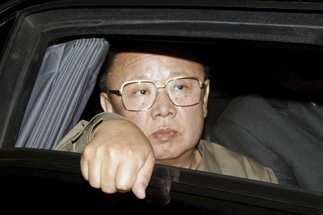Kim’s life as dictator ruthless, odd

North Korean leader Kim Jong-il looks out from a limousine as he leaves Russia’s far eastern city of Vladivostok in this August 23, 2002 file photo. [REUTERS]
There was no sign of Kim at a parade Tuesday marking the 60th anniversary of North Korea’s founding, and Western officials say the 66-year-old leader - who has not appeared publicly for a month - may be gravely ill.
Abroad, many consider the pudgy, bouffant-haired Kim a ruthless dictator who seeks atomic weapons while starving his people. But at home, the state-run media hails the “Dear Leader” as a prodigious general, an ace film director and the “Lodestar of the 21st Century.”
Kim’s portrait is found hanging beside his father’s in North Korean homes and buildings, and his writings and philosophy, mainly praise for his father’s greatness and calls for the defense of socialism, are reported and broadcast daily.
Biographical insight on Kim is extremely sketchy. He rarely appears in public and his voice is seldom broadcast. But defectors from North Korea describe him as an eloquent and tireless orator, primarily to military units that form the base of his support.
The reclusive Kim took power in 1994 after the death of his father, Kim Il Sung, North Korea’s founding ruler. It was communism’s first hereditary transfer of power, and both Kims are revered in a vast personality cult perpetrated by the country’s authoritarian regime, which tolerates no dissent.
Kim Jong-il focused on the military in his songun, or “military-first” credo - devoting much of the country’s scarce resources to its troops - the world’s fifth-largest military, the 1.1 million-strong People’s Army.
The policy was manifested in Kim’s pursuit of nuclear weapons that culminated in North Korea’s first nuclear test explosion in October 2006.
However, Kim shut down the country’s sole nuclear reactor in July 2007 after the United States helped resolve a separate financial dispute.
North Korea suffered famine and poverty in the mid-1990s with as many as 2 million people believed to have died due to the loss of Soviet aid, exacerbated by natural disasters and outdated farming methods.
Kim has laid the blame for North Korea’s problems squarely on outside powers and the country hurls daily propaganda tirades at the United States and Japan.
His image is familiar around the world: short and rotund at 5-foot 3 inches, he wears platform shoes and a bouffant hairstyle to appear taller.
Khaki jumpsuits and sunglasses are his trademark attire. He is said to be a movie fan who owns about 20,000 foreign films.
He reportedly has produced several films, mostly historical epics with an ideological tinge.
He rarely travels abroad and then only by train, once heading all the way by luxury rail car to Moscow, where he also was able to indulge his taste for fine food. Still, he regularly travels within North Korea to military outposts or factories.
After two trains collided at a station in North Korea near the Chinese border in 2004, rumors, never confirmed, circulated that it might have been an assassination attempt. Kim’s train had passed through the station nine hours earlier on the way back from China.
Kim’s foodie ways are legendary but largely unconfirmed. Most of the tales come from defectors, foreign officials, journalists and chefs who got a rare peek inside the all-powerful leader’s bizarre world.
One account of Kim’s lavish lifestyle came from Konstantin Pulikovsky, a former Russian presidential envoy who wrote a book, “The Orient Express,” about Kim’s train trip through Russia in July and August 2001.
Pulikovsky, who accompanied the North Korean leader, said Kim’s 16-car private train was stocked with crates of French wine. Live lobsters were delivered in advance to stations, and gourmet feasts were eaten with silver chopsticks, he said.
Bradley K. Martin’s book “Under the Loving Care of the Fatherly Leader” included an account by Kenji Fujimoto, who claimed to be Kim’s personal sushi chef. The Japanese man said Kim had a 10,000-bottle wine cellar and ate rare shark’s fin soup weekly, the book reported.
“His banquets often started at midnight and lasted until morning. The longest lasted for four days,” the chef was quoted as saying.
Kim is believed to have tempered his habits due to health problems - reported chronic heart disease and diabetes - in recent years and in photos appears to have trimmed his trademark paunch.
He was Kim Il Sung’s eldest son by his late first wife, Kim Jung-sook. North Korea says he was born Feb. 16, 1942, in a “secret camp” at Mount Paektu on the North Korea?China border when his father was supposedly a guerrilla fighter against the Japanese.
Western officials say he was born in the Soviet Union. He has three sons with two women, as well as a daughter by a third, but has not anointed any of them as his successor.
Some believe his eldest son, Kim Jong-nam, fell out of favor after embarrassing his father in 2001, when he was caught trying to enter Japan on a fake passport, saying he wanted to visit Tokyo Disneyland.
AP










with the Korea JoongAng Daily
To write comments, please log in to one of the accounts.
Standards Board Policy (0/250자)